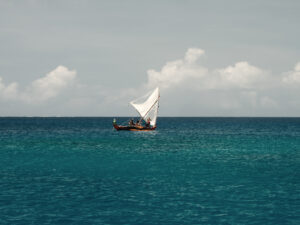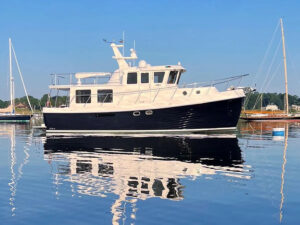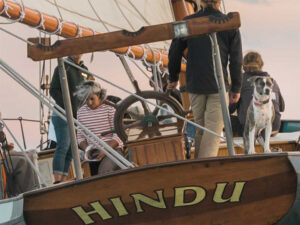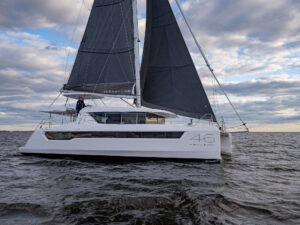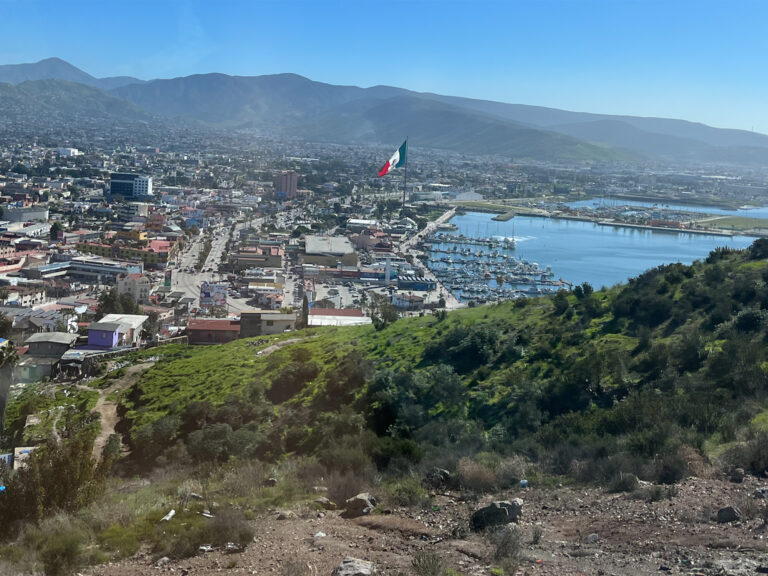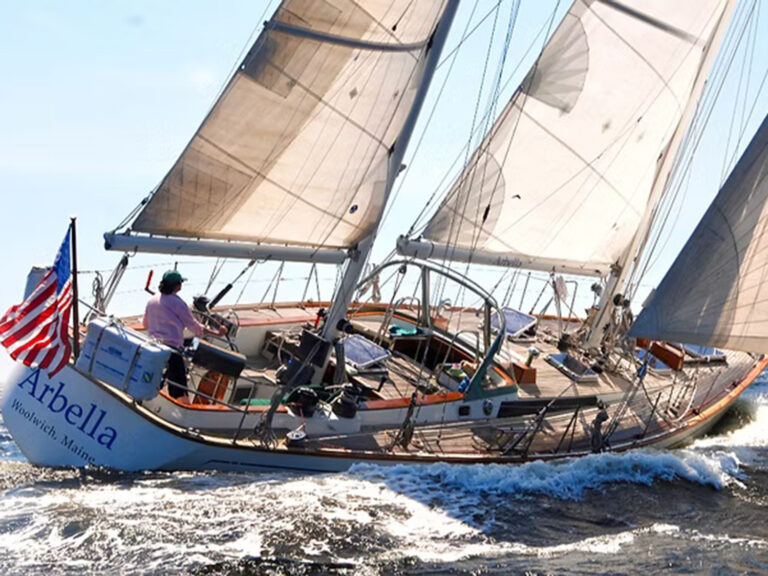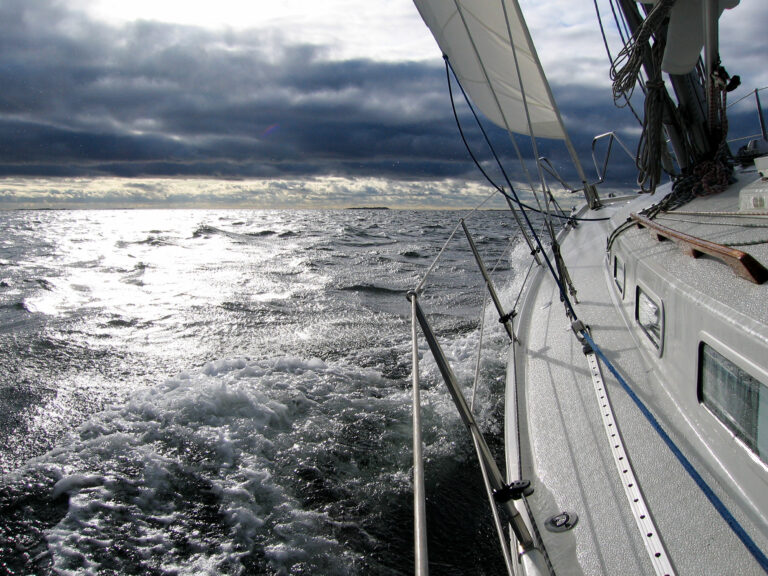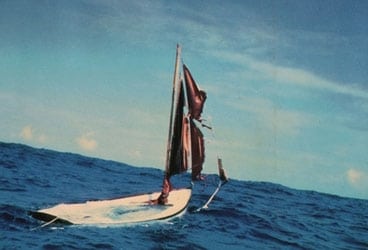
Chidiock Tichborne 368
Now here’s a tale to ponder as you recoup from your Thanksgiving turkey and get ready for the holiday season to come. Webb Chiles, back home in Illinois after completing his fifth circumnavigation aboard the Hawke of Tuonela-he left and returned to his mooring in the Bay of Islands, New Zealand-offers up the following from his journal. It’s an entry entitled, “Evanston: Fools.”-Ed.
I seldom read sailing books any more; but recently a small boat sailor and reader of this journal generously sent me a copy of A Voyage of Pleasure: The Log of Bernard Gilboy’s Transpacific Cruise in the Boat, “Pacific” 1882-1883. I had read this slight volume of only 64 pages several decades ago. Naturally I had forgotten many details and found interest and pleasure in rereading it, particularly from the perspective of greater years and experience.
In 1876 Alfred Johnson made the first solo Atlantic crossing in a 20-foot dory, sailing from Gloucester, Massachusetts, to Abercastle, Wales, in just under two months, with a brief stop in Nova Scotia. Johnson named his boat, Centennial, and said his voyage was to commemorate the nation’s first hundred years.
When I completed my first circumnavigation in 1976, a journalist wanted me to claim that I had done so to honor the Bicentennial. As readers of Storm Passage: Alone Around Cape Horn know, this was not true and I refused.
Inspired by Johnson, Bernard Gilboy, a professional seaman, had an 18-foot schooner built in San Francisco specifically for his voyage, at a cost of $400. He considered this the smallest boat capable of holding provisions for the five months he thought his non-stop passage would take.
Her length of 18 feet and beam of 6 feet were almost identical to those of my open boat, Chidiock Tichborne, but the Pacific had a keel and a draft of 2 feet, 6 inches, as opposed to unballasted Chidiock Tichborne’s 12-inch draft with her centerboard up and 4 inches with it down.
Gilboy writes that he somehow squeezed into his craft: “14 ten-gallon casks, filled with water; 165 pounds of bread, in 15-pound tin cans (air tight); two dozen roast beef in two and-a-half-pound cans; two dozen roast chicken, in one-pound cans; two dozen roast salmon, in one-pound cans; two dozen one-pound cans of boneless pigs-feet; two dozen cans of peaches; two dozen cans of milk; one box containing 25 pounds of cube sugar; one gross of matches, packed in a half dozen glass jars; one half gallon of alcohol, in a druggist’s glass jar; four cans of nut oil-two and a half gallons in a can; five-gallon can of kerosene oil; one bar of Castille soap; three pounds of nails; one wooden pump; 12 feet of half-inch hose, which I used as a siphon to fill the kegs, or get water out of them; one grains (a fish spear), a hammer, and hatchet; paper, copper tacks; kerosene oil stove; alcohol pocket stove; two lamps; one pound of paraffin candles; two compasses, barometer and sextant; patent taff-rail log; double barreled shot gun, powder and shot, revolver and cartridges; clock and watch; nine knives; anchor and sea drogue, with about forty fathoms of 1½” rope; some spare marline amber-line, and marline-spike; navigation books, sheet chart of the South Pacific; an American flag; clothing necessary for the voyage; two pounds of lard; one pair of 12-foot oars; and an umbrella, which I found very handy when the wind was light and the sun strong.”
He needlessly notes that the boat was deep in the water.
And I note one bar of soap for five months.
After obtaining his customs clearance for what was listed as “a voyage of pleasure,” Bernard Gilboy called, “All aboard for Australia,” and shoved off. He made very good time his first week, covering 510 miles, particularly considering that he stopped to sleep, either heaving to or letting the small schooner swing to a sea anchor drogue.
However progress came to a stop when he reached 9 degrees North, and he made only 237 miles in the next 29 days. Finally at 5 degrees North, he started moving again. In describing conditions, Gilboy often uses charming expressions with which I was not familiar, such as “baffling wind” and “mizzling rain.”
Ninety days out of San Francisco he was near Tahiti.
Although San Francisco is 500 miles north of San Diego, in Chidiock Tichborne I was within six miles of Tahiti in 39 sailing days. I was, of course, not carrying provisions for five months.
Disaster struck with the passing of a single wave, which capsized the Pacific south of Fiji on December 12, his 116th at sea, only a few hundred miles southeast of where another single wave flipped Chidiock Tichborne 98 years later.
Gilboy lost a mast, the rudder, his sextant and compass, and almost all of his provisions. Steering with an oar until he made a seamanlike substitute rudder with a jury rig, he struggled on, starving, until on January 29, he was seen and picked up, boat and all, by a passing schooner. At the time he was 200 miles off the Australian Queensland coast.
Gilboy’s almost successful attempt to make the first solo voyage across the Pacific Ocean surely ranks among the greatest almost unknown voyages.
When late in life, Alfred Johnson was asked why he had sailed across the Atlantic alone, he replied, “I made that trip because I was a damned fool, just as they said I was.”
In the March 24, 1883, issue of the San Francisco Daily Alta California newspaper appeared: “The dory Pacific is reported as arrived safely at Australia. Her only occupant gives a thrilling account of his perilous trip. He arrived, as above, and the fools are not all dead yet.”
To which I offer the very last words in Storm Passage: “The fool smiles and sails on.”
This entry and other musings are available at Webb’s website (www.inthepresentsea.com).

